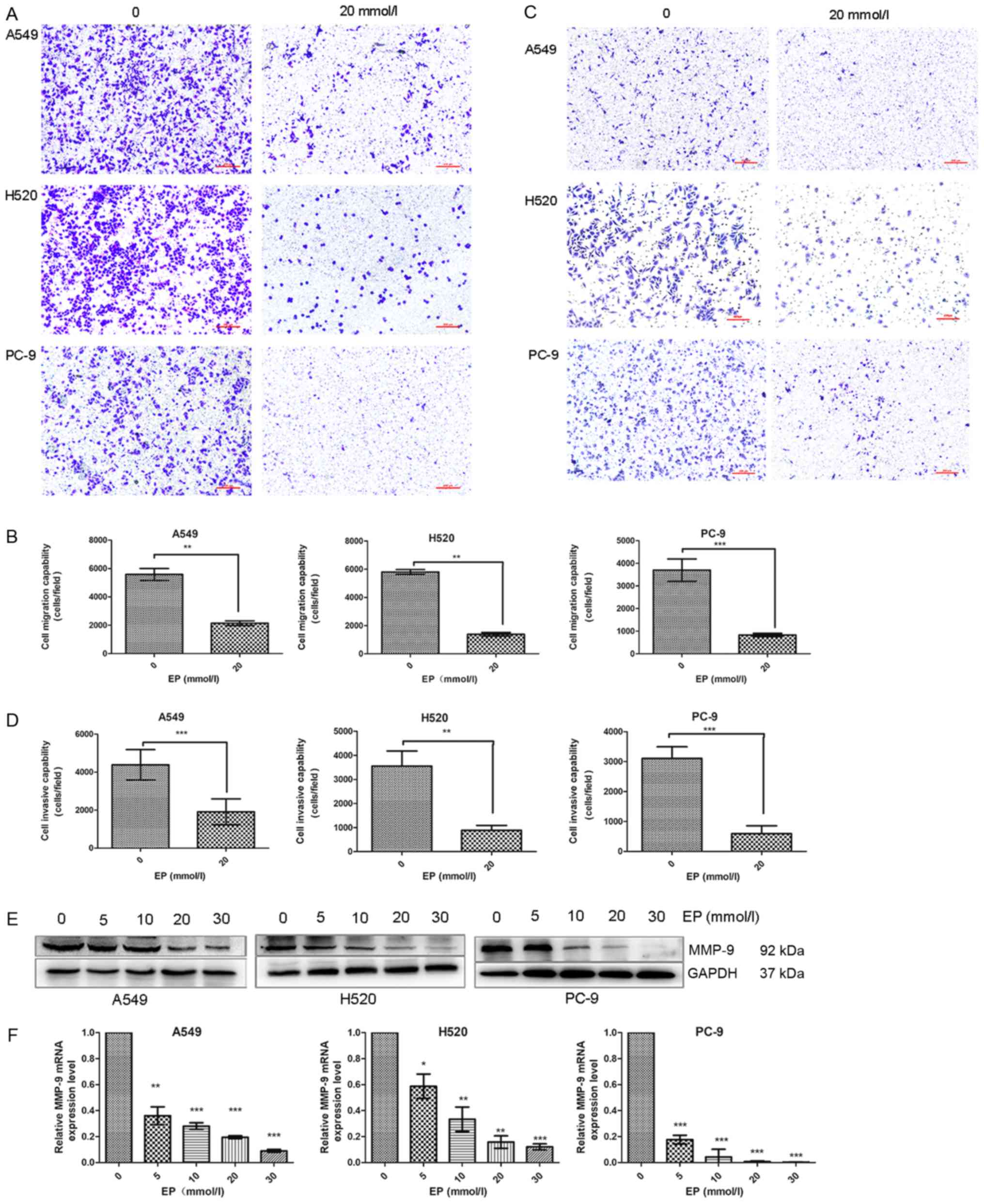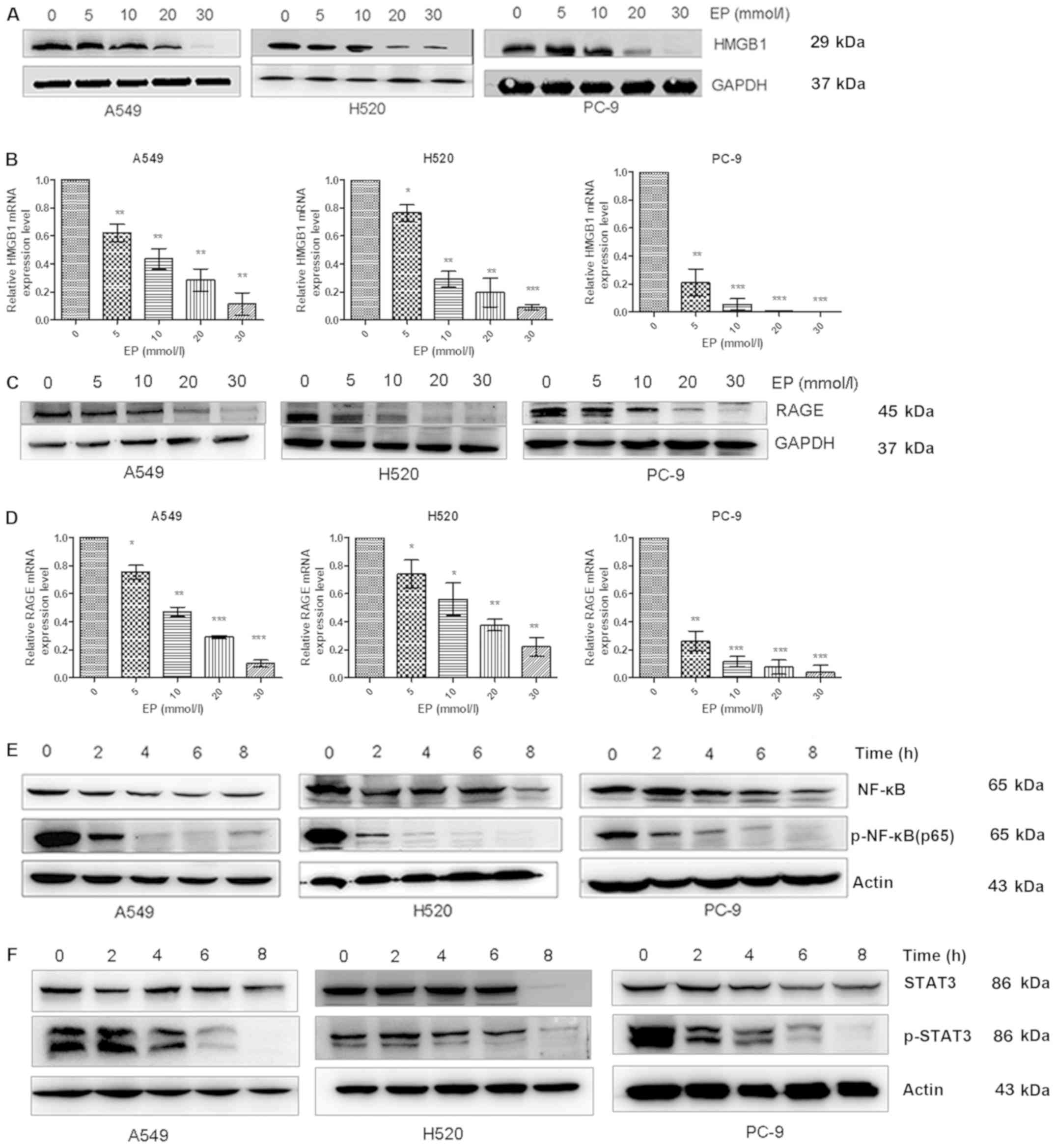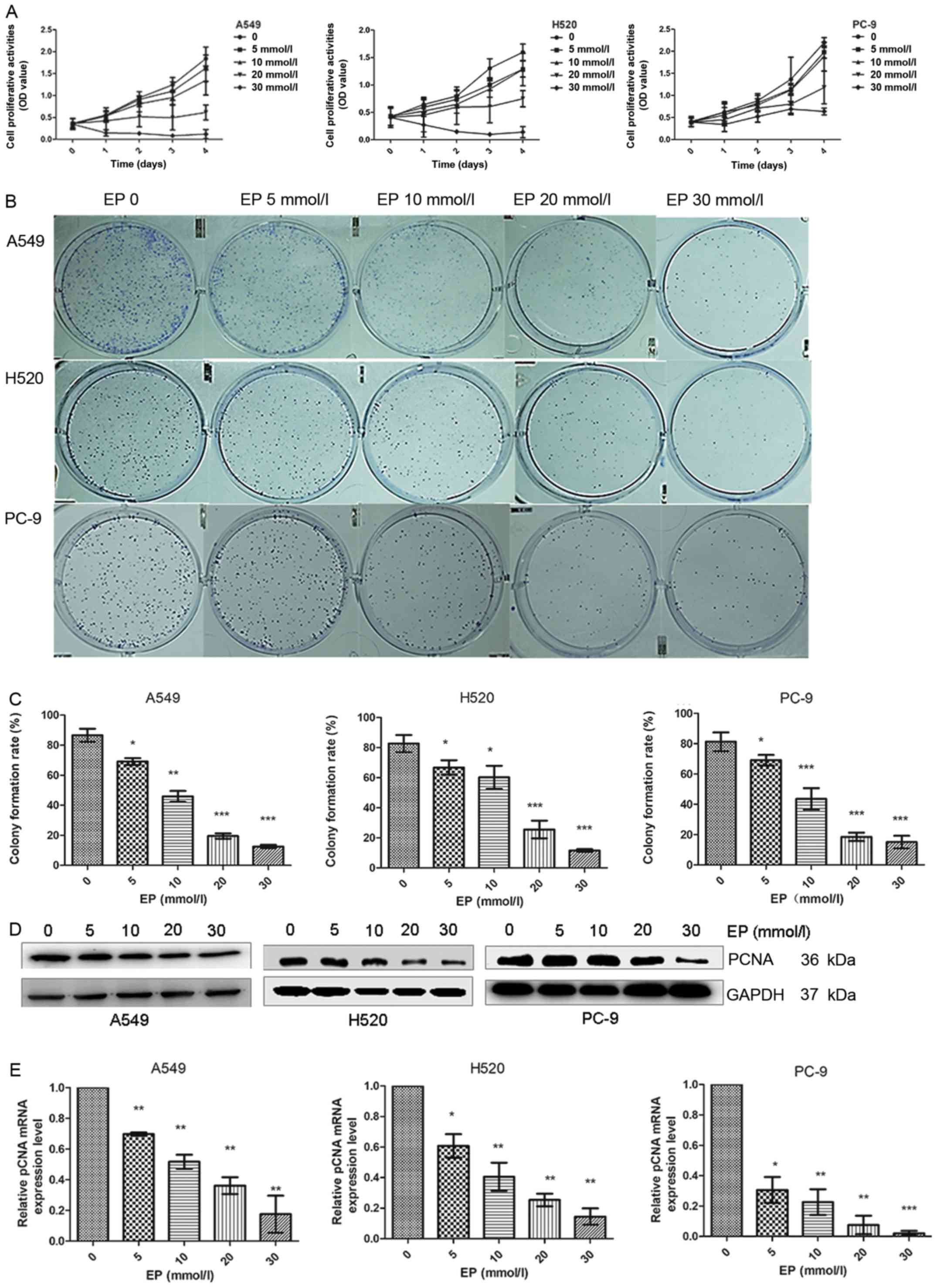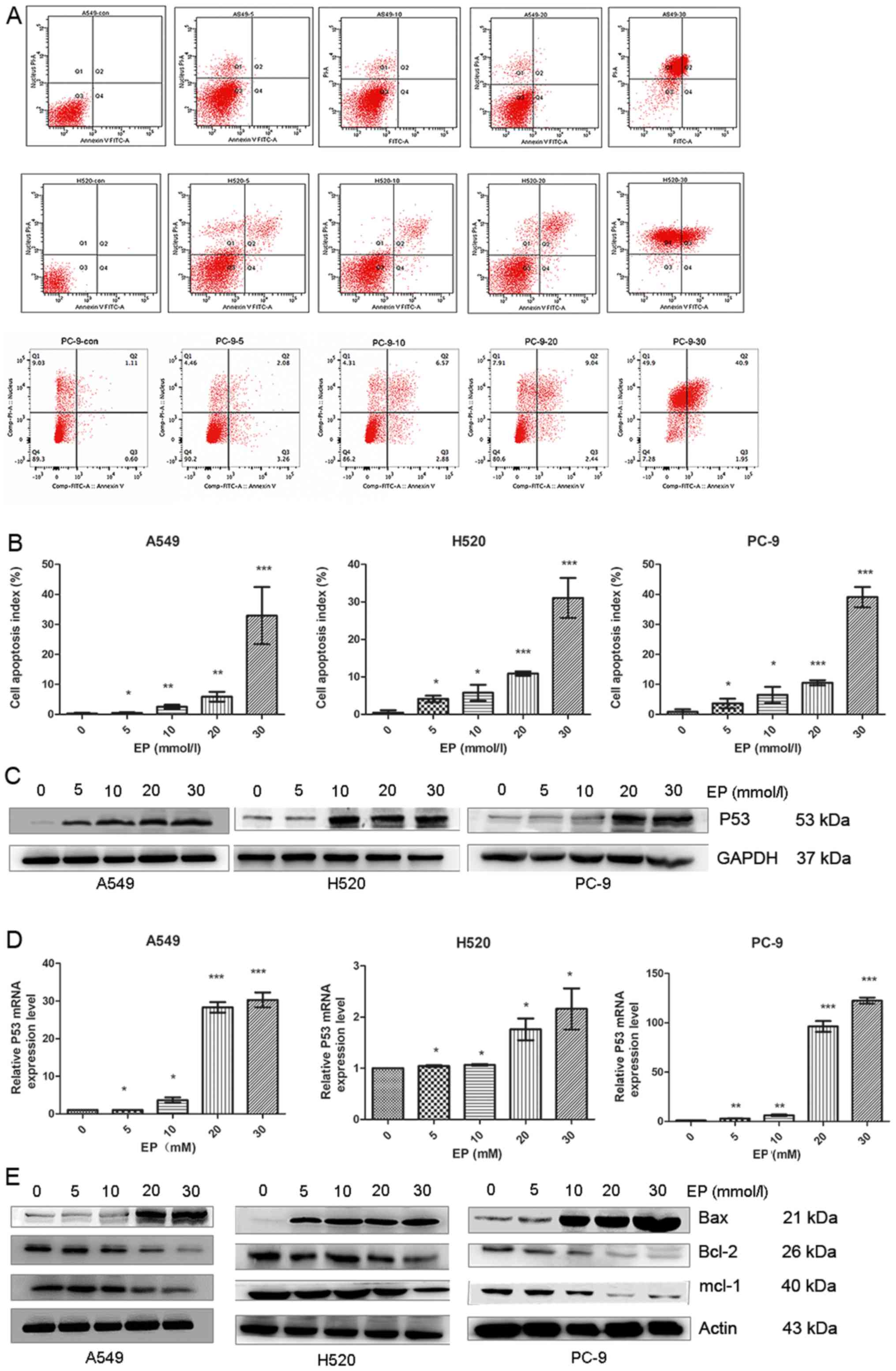|
1
|
Zou S, Pan X, Hua C, Wu M, He B and Chen
Z: Myeloperoxidase-463 G/A polymorphism is associated with lung
cancer risk: A meta-analysis with 7420 cases and 9132 controls. J
Cancer Res Ther. 14 (Suppl):S282–S287. 2018. View Article : Google Scholar : PubMed/NCBI
|
|
2
|
Ziebarth NR: Lung cancer risk perception
biases. Prev Med. 110:16–23. 2018. View Article : Google Scholar : PubMed/NCBI
|
|
3
|
Liu FT, Jia L, Wang P, Farren T, Li H, Hao
X and Agrawal SG: CD126 and targeted therapy with tocilizumab in
chronic lymphocytic leukemia. Clin Cancer Res. 22:2462–2469. 2016.
View Article : Google Scholar : PubMed/NCBI
|
|
4
|
Park BS, Jo HW, Park C, Huh Y, Jung J and
Jeong NY: A novel effect of ethyl pyruvate in Schwann cell
de-differentiation and proliferation during Wallerian degeneration.
Anim Cells Syst. 19:262–268. 2015. View Article : Google Scholar
|
|
5
|
Li X, Jiang S and Tapping RI: Toll-like
receptor signaling in cell proliferation and survival. Cytokine.
49:1–9. 2010. View Article : Google Scholar : PubMed/NCBI
|
|
6
|
Gruffaz M, Vasan K, Tan B, Ramos da Silva
S and Gao SJ: TLR4-mediated inflammation promotes KSHV-induced
cellular transformation and tumorigenesis by activating the STAT3
pathway. Cancer Res. 77:7094–7108. 2017. View Article : Google Scholar : PubMed/NCBI
|
|
7
|
Su X, Wang H, Zhao J, Pan H and Mao L:
Beneficial effects of ethyl pyruvate through inhibiting
high-mobility group box 1 expression and TLR4/NF-κB pathway after
traumatic brain injury in the rat. Mediators Inflamm.
2011:8071422012.
|
|
8
|
Shao Y, Nanayakkara G, Cheng J, Cueto R,
Yang WY, Park JY, Wang H and Yang X: Lysophospholipids and their
receptors serve as conditional DAMPs and DAMP receptors in tissue
oxidative and inflammatory injury. Antioxid Redox Signal. Apr
26–2017.(Epub ahead of print). doi: 10.1089/ars.2017.7069.
|
|
9
|
Lin TJ, Lin HT, Chang WT, Mitapalli SP,
Hsiao PW, Yin SY and Yang NS: Shikonin-enhanced cell immunogenicity
of tumor vaccine is mediated by the differential effects of DAMP
components. Mol Cancer. 14:1742015. View Article : Google Scholar : PubMed/NCBI
|
|
10
|
Bierhaus A, Schiekofer S, Schwaninger M,
Andrassy M, Humpert PM, Chen J, Hong M, Luther T, Henle T, Klöting
I, et al: Diabetes-associated sustained activation of the
transcription factor nuclear factor-kappaB. Diabetes. 50:2792–2808.
2001. View Article : Google Scholar : PubMed/NCBI
|
|
11
|
Baldwin AS Jr: The NF-kappa B and I kappa
B proteins: New discoveries and insights. Annu Rev Immunol.
14:649–683. 1996. View Article : Google Scholar : PubMed/NCBI
|
|
12
|
Müller M, Morotti A and Ponzetto C:
Activation of NF-kappaB is essential for hepatocyte growth
factor-mediated proliferation and tubulogenesis. Mol Cell Biol.
22:1060–1072. 2002. View Article : Google Scholar : PubMed/NCBI
|
|
13
|
Mantovani A, Allavena P, Sica A and
Balkwill F: Cancer-related inflammation. Nature. 454:436–444. 2008.
View Article : Google Scholar : PubMed/NCBI
|
|
14
|
Grivennikov S, Karin E, Terzic J, Mucida
D, Yu GY, Vallabhapurapu S, Scheller J, Rose-John S, Cheroutre H,
Eckmann L and Karin M: IL-6 and Stat3 are required for survival of
intestinal epithelial cells and development of colitis-associated
cancer. Cancer Cell. 15:103–113. 2009. View Article : Google Scholar : PubMed/NCBI
|
|
15
|
Shen Y, Devgan G, Darnell JE Jr and
Bromberg JF: Constitutively activated Stat3 protects fibroblasts
from serum withdrawal and UV-induced apoptosis and antagonizes the
proapoptotic effects of activated Stat1. Proc Natl Acad Sci USA.
98:1543–1548. 2001. View Article : Google Scholar : PubMed/NCBI
|
|
16
|
Pathak M, Mishra R, Agarwala PK, Ojha H,
Singh B, Singh A and Kukreti S: Binding of ethyl pyruvate to bovine
serum albumin: Calorimetric, spectroscopic and molecular docking
studies. Thermochim Acta. 633:140–148. 2016. View Article : Google Scholar
|
|
17
|
Cook VL, Holcombe SJ, Gandy JC, Corl CM
and Sordillo LM: Ethyl pyruvate decreases proinflammatory gene
expression in lipopolysaccharide-stimulated equine monocytes. Vet
Immunol Immunopathol. 141:92–99. 2011. View Article : Google Scholar : PubMed/NCBI
|
|
18
|
Wagner N, Dieteren S, Franz N, Köhler K,
Mörs K, Nicin L, Schmidt J, Perl M, Marzi I and Relja B: Ethyl
pyruvate ameliorates hepatic injury following blunt chest trauma
and hemorrhagic shock by reducing local inflammation, NF-kappaB
activation and HMGB1 release. PLoS One. 13:e0192171doi:
10.1371/journal.pone.0192171. eCollection. 2018. View Article : Google Scholar : PubMed/NCBI
|
|
19
|
Wang FC, Xie Y and Zhou NJ: Ethyl pyruvate
reduced h pylori- induced inflammation through inhibition of
HMGB1/TLR4 pathways. J Gastroenterol Hepatol. 29:27. 2014.
|
|
20
|
Shen HX, Hu XM, Liu C, Wang SP, Zhang WT,
Gao H, Steder RA, Gao YQ and Chen J: Ethyl pyruvate protects
against hypoxic-ischemic brain injury via anti-cell death and
anti-inflammatory mechanisms. Neurobiol Dis. 37:711–722. 2010.
View Article : Google Scholar : PubMed/NCBI
|
|
21
|
Shen M, Lu J, Dai W, Wang F, Xu L, Chen K,
He L, Cheng P, Zhang Y, Wang C, et al: Ethyl pyruvate ameliorates
hepatic ischemia-reperfusion injury by inhibiting intrinsic pathway
of apoptosis and autophagy. Mediators Inflamm. 2013:4615362013.
View Article : Google Scholar : PubMed/NCBI
|
|
22
|
Chakhtoura M, Chain R, Varghese L and
Gallucci S: Ethyl pyruvate, an inhibitor of high-mobility group box
1 (HMGB1) release, modulates dendritic cell activation and survival
(TRAN3P.897). J Immunol 192 (1 Suppl). S202–S236. 2014.
|
|
23
|
Livak KJ and Schmittgen TD: Analysis of
relative gene expression data using real-time quantitative PCR and
the 2(-Delta Delta C(T)) method. Methods. 25:402–408. 2011.
View Article : Google Scholar
|
|
24
|
Ibrahim ZA, Armour CL, Phipps S and Sukkar
MB: RAGE and TLRs: Relatives, friends or neighbours? Mol Immunol.
56:739–744. 2013. View Article : Google Scholar : PubMed/NCBI
|
|
25
|
Han SH, Kim YH and Mook-Jung I: RAGE: The
beneficial and deleterious effects by diverse mechanisms of
actions. Mol Cells. 31:91–97. 2011. View Article : Google Scholar : PubMed/NCBI
|
|
26
|
Perkins ND: Integrating cell-signalling
pathways with NF-kappaB and IKK function. Nat Rev Mol Cell Biol.
8:49–62. 2007. View
Article : Google Scholar : PubMed/NCBI
|
|
27
|
Yu H, Pardoll D and Jove R: STATs in
cancer inflammation and immunity: A leading role for STAT3. Nat Rev
Cancer. 9:798–809. 2009. View
Article : Google Scholar : PubMed/NCBI
|
|
28
|
Hanahan D and Weinberg RA: Hallmarks of
cancer: The next generation. Cell. 144:646–674. 2011. View Article : Google Scholar : PubMed/NCBI
|
|
29
|
Actis M, Inoue A, Evison B, Perry S,
Punchihewa C and Fujii N: Small molecule inhibitors of PCNA/PIP-box
interaction suppress translesion DNA synthesis. Bioorg Med Chem.
21:1972–1977. 2013. View Article : Google Scholar : PubMed/NCBI
|
|
30
|
Abike F, Tapisiz OL, Zergeroglu S, Dunder
I, Temizkan O and Payasli A: PCNA and Ki-67 in endometrial
hyperplasias and evaluation of the potential of malignancy. Eur J
Gynaecol Oncol. 32:77–80. 2011.PubMed/NCBI
|
|
31
|
Himelstein BP, Canete-Soler R, Bernhard
EJ, Dilks DW and Muschel RJ: Metalloproteinases in tumor
progression: The contribution of MMP-9. Invasion Metastasis.
14:246–258. 1994.PubMed/NCBI
|
|
32
|
Morini M, Mottolese M, Ferrari N, Ghiorzo
F, Buglioni S, Mortarini R, Noonan DM, Natali PG and Albini A: The
alpha 3 beta 1 integrin is associated with mammary carcinoma cell
metastasis, invasion, and gelatinase B (MMP-9) activity. Int J
Cancer. 87:336–342. 2000. View Article : Google Scholar : PubMed/NCBI
|
|
33
|
Farina AR and Mackay AR: Gelatinase
B/MMP-9 in tumour pathogenesis and progression. Cancers (Basel).
6:240–296. 2014. View Article : Google Scholar : PubMed/NCBI
|
|
34
|
Zhang L, Ma L, Yan T, Han X, Xu J, Xu J
and Xu X: Activated mitochondrial apoptosis in hESCs after
dissociation involving the PKA/p-p53/Bax signaling pathway. Exp
Cell Res. 369:226–233. 2018. View Article : Google Scholar : PubMed/NCBI
|
|
35
|
Yao TH, Pataer P, Regmi KP, Gu XW, Li QY,
Du JT, Ge SM and Tu JB: Propranolol induces hemangioma endothelial
cell apoptosis via a p53-BAX mediated pathway. Mol Med Rep.
18:684–694. 2018.PubMed/NCBI
|
|
36
|
Youle RJ and Strasser A: The BCL-2 protein
family: Opposing activities that mediate cell death. Nat Rev Mol
Cell Biol. 9:47–59. 2008. View
Article : Google Scholar : PubMed/NCBI
|
|
37
|
Zhang J, Zhu JS, Zhou Z, Chen WX and Chen
NW: Inhibitory effects of ethyl pyruvate administration on human
gastric cancer growth via regulation of the HMGB1-RAGE and Akt
pathways in vitro and in vivo. Oncol Rep.
27:1511–1519. 2012.PubMed/NCBI
|
|
38
|
Birkenmeier G, Hemdan NYA, Kurz S, Bigl M,
Pieroh P, Debebe T, Buchold M, Thieme R, Wichmann G and Dehghani F:
Ethyl pyruvate combats human leukemia cells but spares normal blood
cells. PLoS One. 11:e01615712016. View Article : Google Scholar : PubMed/NCBI
|
|
39
|
Pellegrini L, Xue J, Larson D, Pastorino
S, Jube S, Forest KH, Saad-Jube ZS, Napolitano A, Pagano I, Negi
VS, et al: HMGB1 targeting by ethyl pyruvate suppresses malignant
phenotype of human mesothelioma. Oncotarget. 8:22649–22661. 2017.
View Article : Google Scholar : PubMed/NCBI
|
|
40
|
Cheng P, Dai W, Wang F, Lu J, Shen M, Chen
K, Li JJ, Zhang Y, Wang C, Yang J, et al: Ethyl pyruvate inhibits
proliferation and induces apoptosis of hepatocellular carcinoma via
regulation of the HMGB1-RAGE and AKT pathways. Biochem Biophys Res
Commun. 443:1162–1168. 2014. View Article : Google Scholar : PubMed/NCBI
|
|
41
|
Baunacke M, Horn LC, Trettner S, Engel KM,
Hemdan NY, Wiechmann V, Stolzenburg JU, Bigl M and Birkenmeier G:
Exploring glyoxalase 1 expression in prostate cancer tissues:
Targeting the enzyme by ethyl pyruvate defangs some
malignancy-associated properties. Prostate. 74:48–60. 2014.
View Article : Google Scholar : PubMed/NCBI
|
|
42
|
Li ML, Wang XF, Tan ZJ, Dong P, Gu J, Lu
JH, Wu XS, Zhang L, Ding QC, Wu WG, et al: Ethyl pyruvate
administration suppresses growth and invasion of gallbladder cancer
cells via downregulation of HMGB1-RAGE axis. Int J Immunopathol
Pharmacol. 25:955–965. 2012. View Article : Google Scholar : PubMed/NCBI
|
|
43
|
Queisser MA, Kouri FM, Königshoff M,
Wygrecka M, Schubert U, Eickelberg O and Preissner KT: Loss of RAGE
in pulmonary fibrosis: Molecular relations to functional changes in
pulmonary cell types. Am J Respir Cell Mol Biol. 39:337–345. 2008.
View Article : Google Scholar : PubMed/NCBI
|
|
44
|
Xu X, Zhu H, Wang T, Sun Y, Ni P, Liu Y,
Tian S, Amoah Barnie P, Shen H, Xu W, et al: Exogenous
high-mobility group box 1 inhibits apoptosis and promotes the
proliferation of lewis cells via RAGE/TLR4-dependent signal
pathways. Scand J Immunol. 79:386–394. 2014. View Article : Google Scholar : PubMed/NCBI
|
|
45
|
Gilmore TD: Introduction to NF-kappaB:
Players, pathways, perspectives. Oncogene. 25:6680–6684. 2006.
View Article : Google Scholar : PubMed/NCBI
|
|
46
|
Escárcega RO, Fuentes-Alexandro S,
Garcia-Carrasco M, Gatica A and Zamora A: The transcription factor
nuclear factor-kappa B and cancer. Clin Oncol (R Coll Radiol).
19:154–561. 2007. View Article : Google Scholar : PubMed/NCBI
|
|
47
|
Yuan ZL, Guan YJ, Wang L, Wei W, Kane AB
and Chin YE: Central role of the threonine residue within the p+1
loop of receptor tyrosine kinase in STAT3 constitutive
phosphorylation in metastatic cancer cells. Mol Cell Biol.
24:9390–9400. 2004. View Article : Google Scholar : PubMed/NCBI
|
|
48
|
Bennett-Guerrero E, Swaminathan M, Grigore
AM, Roach GW, Aberle LG, Johnston JM and Fink MP: A phase II
multicenter double-blind placebo-controlled study of ethyl pyruvate
in high-risk patients undergoing cardiac surgery with
cardiopulmonary bypass. J Cardiothorac Vasc Anesth. 23:324–329.
2009. View Article : Google Scholar : PubMed/NCBI
|
|
49
|
Tang D, Kang R, Cheh CW, Livesey KM, Liang
X, Schapiro NE, Benschop R, Sparvero LJ, Amoscato AA, Tracey KJ, et
al: HMGB1 release and redox regulates autophagy and apoptosis in
cancer cells. Oncogene. 29:5299–5310. 2010. View Article : Google Scholar : PubMed/NCBI
|


















